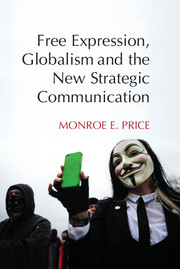Book contents
- Frontmatter
- Contents
- Acknowledgments
- 1 Moving the Needle, Filling the Streets
- 2 Strategic Communication and the Foundations of Free Expression
- 3 Narratives of Legitimacy
- 4 Strategies of the Diagnostic
- 5 Asymmetries and Strategic Communication
- 6 Strategies of System Architecture
- 7 Soft Power, Soft War
- 8 Religions and Strategic Communication
- 9 Regulating NGOs in the Market for Loyalties
- 10 Strategic Platforms
- 11 Strategic Communication and Satellite Channels
- 12 Strategies of Closure, Markers of Anxiety
- Bibliography
- Index
- References
5 - Asymmetries and Strategic Communication
Published online by Cambridge University Press: 18 December 2014
- Frontmatter
- Contents
- Acknowledgments
- 1 Moving the Needle, Filling the Streets
- 2 Strategic Communication and the Foundations of Free Expression
- 3 Narratives of Legitimacy
- 4 Strategies of the Diagnostic
- 5 Asymmetries and Strategic Communication
- 6 Strategies of System Architecture
- 7 Soft Power, Soft War
- 8 Religions and Strategic Communication
- 9 Regulating NGOs in the Market for Loyalties
- 10 Strategic Platforms
- 11 Strategic Communication and Satellite Channels
- 12 Strategies of Closure, Markers of Anxiety
- Bibliography
- Index
- References
Summary
On April 24, 2011, in the early days of the Syrian civil conflict, the New York Times reported a curious imbalance. In the absence of systematic access by reporters to the scene, one or two dozen diasporic “geeks” were a principal source for capturing and shaping the way the narrative of the Syrian protests was being received in Western capitals. These amateurs were, at the time, outperforming the entire Syrian government in the process of informing the world of the nature of the emerging conflict and the Syrian leadership’s response. As the Times reported, the small number of activists “coordinated across almost every time zone and managed to smuggle hundreds of satellite and mobile phones, modems, laptops and cameras into Syria. There, compatriots elude surveillance with e-mailed software and upload videos on dial-up connections.” The intense efforts presented a sharp contrast with global coverage of civil disobedience and protest in Syria in 1982. Then, noted the Times, Syria’s government managed to hide “its massacre of at least 10,000 people in Hama in a brutal crackdown of an Islamist revolt. But [now], the world could witness, in almost real time, the chants of anger and cries for the fallen as security forces fired on the funerals for Friday’s dead.” President Bashar Assad’s government was left staggered by the coverage, forced to face the reality that it “has almost entirely ceded the narrative of the revolt to its opponents at home and abroad.” For Joshua Landis, a professor of Middle East studies at the University of Oklahoma, this led to an interesting, not necessarily exaggerated, conclusion: “These activists have completely flipped the balance of power on the regime, and that’s all due to social media.”
- Type
- Chapter
- Information
- Publisher: Cambridge University PressPrint publication year: 2014



